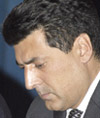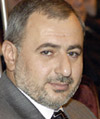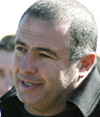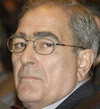In the political aspect the holidays of the current year principally differ from the previous ones because (a) it is a pre-election year, (b) various western political wings think that it is a “convenient” year for the solution of the Karabagh conflict, (c) starting from January 1 the gas price will be raised, which will considerably tense the comparably sustainable social conditions of the population. The last article of the previous year may be considered a geopolitical session, according to which the Russian Federation, USA, Europe and Iran will be simultaneously competing with different Armenian political forces on different game boards. Thus:
 Game board #1 – ARP
Game board #1 – ARP
During the meeting of December 17 the Armenian Republican Party made everybody understand that they’re starting their pre-election campaign. The ARP is going to participate all alone and gain no fewer votes than during the previous elections. It is assumed that the ARP and Serj Sargisyan alliance will be formed this time again. There is one “but” here though. Unlike the 2002 elections, this time Gagik Tsarukyan (“Prosperous Armenia” Party), Samvel Babayan (“Alliance” Party), Karen Karapetyan (“National Deputy”) are also in the game. The ARP has previously competed for proportional seats. They did not have problems for majority seats. However, during the 2007 elections, they will have to compete in two fronts – both proportional and majority seats.
Strong side: Serj Sargisyan’s role, political pragmatism of Andranik Margaryan, administrative resources, large experience of political competition.
Weaknesses: Governmental party, inner party issues, weak PR, absence of personal media.
 Game board #2 – “Legal State” Party
Game board #2 – “Legal State” Party
The “Legal State” was the first to start the pre-election campaign out of the other coalition parties. Furthermore they started to campaign against their coalition colleagues. By taking into account the steps of the Chairman of the “Legal State” Artur Baghdasaryan after the referendum we may presume close cooperation of the “Legal State” with the opposition parties as well as with the leaders of the newly-established parties (the recent Artur Baghdasaryan-Samvel Babayan meeting). The “Legal State” succeeded in grabbing a few majority seats in the parliament in the 2002 elections. Perhaps this time they won’t succeed in it.
Strong sides: Support of certain geopolitical forces, literate populism, correct PR, comparably strong branches.
Weaknesses: Governmental party, weak personnel, lack of decisiveness, lack of personal media.
 Game board # 3 – Armenian Revolutionary Party
Game board # 3 – Armenian Revolutionary Party
By realizing that the party is going to lag behind other parties during the coming elections one of the leaders of the party Hrant Margaryan sent an open letter to Robert Kocharyan in regard to the illegalities proceeding in Armenia. The practice shows that the Armenian Revolutionary Party can only gain 8-10% of votes. By realizing that they cannot gain votes through majority elections they did their best to persuade the parliament to adopt a new electoral code by increasing the number of proportional seats. Like the “Legal State” the Armenian Revolutionary Party will be cooperating with the opposition and the newly established parties.
Strong sides: support on the part of certain geopolitical forces, certain stable electorate, certain ideological grounds, large practice of political competition, ideological fanatism.
Weaknesses: Governmental party, stereotyped ideology, broken promises.
 Game board #4 – APP
Game board #4 – APP
It is evident that this time the APP will go to the elections all alone. Indeed, in this prospect Stepan Demirchyan will not have as many votes as he had during the 2002 elections because the votes will also split in the opposition political field. But everybody understands that there is the need to give a few seats for the APP in the parliament for the sake of democracy.
Strong sides: The rating of the APP since Karen Demirchyan, opposition party, certain sustainable electorate.
Weaknesses: Ideology and complete absence of experience, in the political aspect – a very static leader.
 Game board #5 – “National Unity” Party
Game board #5 – “National Unity” Party
The NU is going to be led by the same rules of the game as in 2002. That is – gain certain percent of votes and be satisfied by that. Anyhow at least the passiveness that Artashes Geghamyan shows after April 2004 makes us consent with the mentioned idea.
Strong sides: Literate populism, opposition party, certain stable electorate, great experience of political competition, charismatic leader.
Weaknesses: Passiveness (visual passiveness), the leader’s age, frequent transition from one wing to another, super ambitions of the party and its leader.
 Game board #6 – Armenian National Movement
Game board #6 – Armenian National Movement
After the long-year silence and passiveness the ANM has become quite active (in particular during the recent protests). If we take into account the nostalgic tempers characteristic to the Armenian mentality there might be a possibility for the ANM to open certain horizon of success.
Strong sides: Opposition party, intellectual potential, certain stable electorate, experience of political fight, charismatic leader, support on the part of certain geopolitical forces.
Weaknesses: Passiveness, memories about the cold and dark years, representative conflicts.
 Game board #7 – “Prosperous Armenia” Party
Game board #7 – “Prosperous Armenia” Party
After the last interview with Gagik Tsarukyan it becomes clear that the government is planning to create another powerful pyramid. This party will try to occupy a number of majority seats in the National Assembly.
Strong sides: Huge financial resources, model of a succeeded practice in Kotayk Marz, an image of a charitable leader.
Weaknesses: Little political experience, pro-governmental behavior.
 Game board #8 – “Hayastan” committee
Game board #8 – “Hayastan” committee
Newly formed political pole, where it is possible to see both Russian and Western oriented forces. They have not done anything but come up with revolutionary announcements so far. The committee includes quite experienced political figures.
Strong Sides: Ability to unite, strong electorate, great experience of political competition.
Weaknesses: Broken promises, weak financial resources, absence of PR, weak branches.
 Game board #9 – United Labor Party
Game board #9 – United Labor Party
By entering into the political field quite quickly, they may lose their positions because of both personal actions and the presence of new forces.
Strong sides: Intellectual potential, financial resources, PR.
Weaknesses: Lack of cadres, one-person management of the party, political disorientation.
 Game board # 10 – “Alliance” Party
Game board # 10 – “Alliance” Party
This party has not originally concealed it goals and direction. However by analyzing the media it becomes clear that this party will have opponents and supporters in both government and opposition.
Strong sides: Financial resources, young elite of the party that inspires strength.
Weaknesses: Origins are from Karabakh, absence of party and political practice, party established on the basis of time demand.
 Game board #11 – “People’s Deputy” Party
Game board #11 – “People’s Deputy” Party
The party will have the same format as the “Prosperous Armenia” Party.
 Game board #12 – “People’s Party”
Game board #12 – “People’s Party”
This is the most unpredictable party that has super popular leader and powerful TV company. However, all the other attributes of politics are totally absent (may become a “kinder-surprise” of the next elections.
 Game board #13 – “Ramkavar” Party, “Mighty State”, “Dignity” and others
Game board #13 – “Ramkavar” Party, “Mighty State”, “Dignity” and others
The practice shows that if these parties don’t join any powerful force during the elections then they will have no chance to have a victory during those elections.
